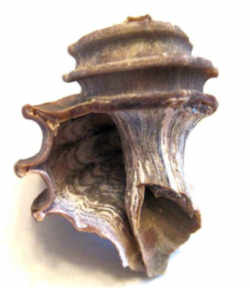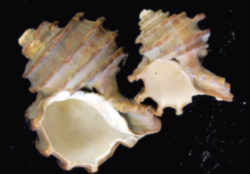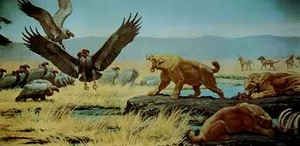Maryland State Fossil Shell
Extinct Snail

(Ecphora gardnerae gardnerae)
Adopted on October 1, 1994.
In 1994, the Extinct Snail, (Ecphora gardnerae gardnerae,) (Wilson) (an extinct snail) was named Maryland State Fossil Shell (Chapter 688, Acts of 1994; Code State Government Article, sec. 13-311).
The Ecphora inhabited Chesapeake Bay and other East Coast tidal waters in the Miocene era, some 3 million years ago. Specimens have been recovered from Calvert Cliffs, Calvert County, and Chancellor Point, St. Mary's County.
Maryland State Fossil: Extinct Snail
Scientific Name

This russet-colored fossil shell derives its genus name from the Greek ekphora, meaning "protruding." The more recent species designation of gardnerae is in honor of paleontologist Julia Gardner of the US Geological Survey. The subspecies name is a repetition of the species name, and the name "Wilson" denotes the person who originated the species name.
As of October 1, 1994, the official fossil shell of Maryland is an extinct snail, or gastropod: Ecphora gardnerae gardnerae Wilson. Actually,
this same fossil snail was first designated by the Maryland General Assembly in 1984, but there has been a name change. The legislature's action in
1994 was in response to a name change by the scientific community. The previous name was Ecphora quadricostata (Say). Changes in nomenclature are nothing
new for Ecphora (or for most fossils, for that matter).
This fossil snail was one of the first fossils from the New World to be illustrated in a scientific work in Europe. It has been reported that a rather
poor drawing of an Ecphora first appeared in William Huddesford's printing of the third edition of Martin Lister's "Historiae Conchyliorum" (or History
of Conchs) in 1770 in England. It was labelled "a marilandia," or "from Maryland." (Contrary to what has appeared in print at least are far back as
1904, this fossil was not the first from North America to be so illustrated. That honor likely falls to a fossil clam, now known as Chesapecten
jeffersonius, which appeared in Lister's own first edition in 1687.)
The shells of the various species and subspecies of the genus Ecphora constitute one of the most unusual and diagnostic types of fossil in the Miocene
fauna of the mid-Atlantic region. Key characteristics that aid in identification by collectors are
(1) a russet color, which contrasts with the more common white color of most other mollusks;
(2) four strongly protruding "ribs," or costae, which are T-shaped in cross section; and
(3) its moderately wide umbilicus, which is a hollow cone-shaped feature along the axis of coiling
You might wonder why the names of fossils are sometimes changed. And why do fossils have such "odd" names? Proposing names and changing names are
not whimsical. Paleontologists have shown that there were differences between the Ecphora quadricostata from the upper part of the St. Marys
Formation (Miocene age) of Maryland and the Ecphora quadricostata from the lower Pliocene strata of tidewater Virginia. Since the species
designation E. quadricostata had first been assigned to the fossil from Virginia (thus giving its name priority), the scientific name of the Miocene
gastropod from Maryland had to be changed. The honor of naming a fossil falls to the paleontologists who first publishes the revised classification
and nomenclature. In this case, that was Druid Wilson, who was working for the Smithsonian Institution at the time. In 1987, he proposed the name
Ecphora gardnerae. Soon after that, two other paleontologists (Ward and Gilinski, 1988) further subdivided the genus Ecphora, and introduced
several subspecies. Thus was born the name of Ecphora gardnerae gardnerae Wilson for the distinctive fossil shell. (Strictly speaking, from
a taxonomy and nomenclature viewpoint, "Wilson" is part of the complete name and should not be in parentheses.) There are other species and subspecies
of Ecphora in the Miocene strata of Southern Maryland, and they each have their own distinguishing characteristics.
The name of the genus often, but not always, is derived from a Latin or Greek word that is descriptive of some key characteristic of the organism.
The second part of the name identifies the species and also derives from Latin or Greek. The species name may reflect some characteristic feature of
the organism, or refer to the locality where it was first found, or may be a "latinized" word in honor of some noted paleontologist. For example, the
Maryland fossil shell derives its genus name from the Greek ekphora, meaning "protruding." The species name, quadricostata, comes from the Latin for
"four ribs" (quad = four; costa = rib)., in reference to the presence of four strongly developed protruding "ribs," or costae. (Note that the T-shape
distinguishes this fossil from other related four-ribbed species of Ecphora.) The more recent species designation of gardnerae is in honor of US Geological
Survey paleontologist Julia Gardner (Wilson, 1987). In this case, the subspecies name is a repetition of the species name, and the name "Wilson" denotes
the person who originated the species name.
The various species of Ecphora are fairly common in the Miocene strata of Maryland. Ecphora inhabited the waters of an earlier stage of the Atlantic
continental shelf, areas now occupied by Chesapeake Bay and parts of Southern Maryland and Eastern Shore. There are several collecting localities for
the various species of Ecphora in Maryland, and they include all three of Maryland's Miocene formations - from oldest to youngest, the Calvert, the
Choptank and the St. Marys Formations. To the amateur collector, it is fairly easy to confuse the various species of Ecphora. The most detailed descriptions
and photographs appear in Ward and Gilinsky (1988). Ecphora gardnerae gardnerae Wilson is known to occur only in the Windmill Point unit of
the upper St. Marys Formation (Ward and Gilinsky, 1988). The best specimens of Ecphora are reported from the renowned Calvert Cliffs north of Little
Cove Point, Calvert County, and from Chancellor Point, St. Marys River, St. Mary's County. Both locales are in the St. Marys Formation. However, these
and most other locales are on private property. All would-be collectors must receive permission from the landowner to hunt fossils on privately owned
land. At Calvert Cliffs State Park in Calvert County, collecting is allowed along a small section of beach, but is not permitted along the cliffs due
to landslide hazard. Although the State Park is rich in many Miocene fossils, it is a poor site for collecting specimens of Ecphora.
Maryland Law
The law designating the extinct snail as the official Maryland state fossil is found in the Maryland Statutes, Title 13, Section 13-311.
STATE GOVERNMMENT
TITLE 13. EMBLEMS; COMMEMORATIVE DAYS; MANUAL.
SUBTITLE 3. ADDITIONAL EMBLEMS; DESIGNATIONS
SECTION 13-311.
§13-311. The Ecphora gardnerae gardnerae (Wilson) is the State fossil shell.
Taxonomic Hierarchy: Extinct Snail
Kingdom: Animalia
Phylum: Mollusca
Class: Gastropoda
(unranked): clade Caenogastropoda
clade Hypsogastropoda
clade Neogastropoda
Superfamily:Muricoidea
Family: Muricidae
Genus: Ecphora
Species: E. gardnerae

Some states that lack a "state fossil" have nevertheless singled out a fossil for formal designation such as a state dinosaur, rock, gem or stone.







